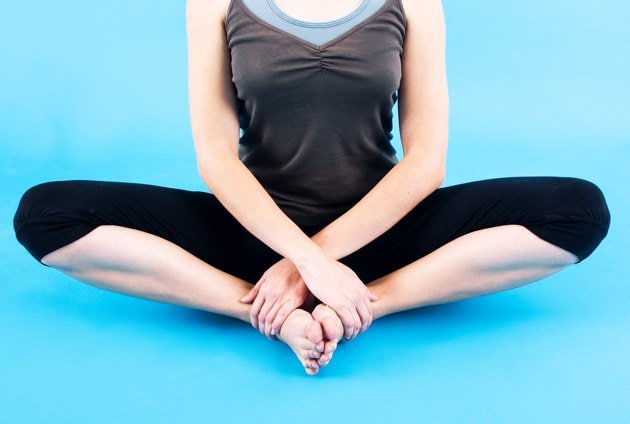When I started my yoga practice, my feet ached after every class. And wide-legged poses like Warrior 2 (Virabhadrasana II), Extended Triangle (Utthita Trikonasana) or Wide-Legged Forward Bend (Prasarita Padottanasana) were the worst.
I couldn’t hold the poses for more than 3 or 5 breaths before the inner arches of my feet would feel like they were on fire. At the time, I assumed this was because I had flat feet, a condition I’d already been struggling with as a runner. Plus I lived and worked in New York City, which meant I walked everywhere in heels.
I was not exactly kind to my feet off the yoga mat, to say the least, and it showed up on the yoga mat.
Shoes Make Feet Schmooze
It’s no surprise shoes can contribute to foot pain. A 2008 New York article proposed that we actually walk wrong because of our shoes and cited a South African study of 180 people which compared European habitual shoe wearers to the Zulu population who typically went barefoot.
The unhealthiest feet in the bunch? The Europeans.
Ultimately, wearing shoes weakens our feet. Think about how mobile our hands and fingers are, then put on a mitten and try to text on your smartphone. That’s essentially what we’re doing to our feet with shoes—limiting our capacity for movement and strength.
Shoes make us think that what is really a limb with five appendages has now become one clumsy club. Hard to imagine us being able to balance in Tree (Vrksasana) on our mats if we’ve been walking around on two clubs for much of our lives, right?
Embrace The Barefoot Freedom And Surf
When we’re barefoot, and our toes can spread and grip the floor, we actually can be more grounded. Our feet become more agile and flexible because they can more easily contour to uneven surfaces as our barefoot ancestors once did centuries before. All these qualities help strengthen our feet, which help prevent sprains and twists.
In yoga, sturdy feet help increase stability and ease in standing poses and one-legged balances. Active, strong feet also help in inversions and arm balances. So it definitely pays to offer more attention to our tootsies in class.
In spite of my initial discomfort, I continued to work my feet in yoga, and not surprisingly, as the stronger and more mobile my feet became, the aches lessened. After some time, I noticed my feet—really noticed them. They looked toned and muscular. I could spread my toes and grip more, as well as flex and extend my foot more easily.
My balance had improved, and I could stand in poses like Extended Hand-to-Big-Toe Pose (Utthita Hasta Padangustasana) for more than five breaths comfortably. Warrior 2 became way more comfortable. I even applied my newfound foot dexterity on the subway; rather than using the poles for balance while the trains zipped and jerked underground, I could easily “surf” on the train car without using my hands.
The Lesson Here: Feet First!
Now, clearly you’re not about to throw your shoes away, but there are some things you can do to treat your feet better. Feet need regular exercise like any other part of our body. Yet, because they are enclosed in shoes for the better part of the day, we usually only notice them when something is wrong or when we unveil them, like in a yoga class.
So think about yoga as your opportunity to make up for all the hours your foot is encased in sneakers, heels, or boots. Most styles of yoga agree that a pose begins from the ground up. When you patiently cultivate more grounding and awareness through your feet, your poses are that much more sustainable.
Many teachers will also mention rooting down through the four corners of your foot: the big toe mound, the little toe mound, the inner heel and the outer heel. Your stability is that much stronger when these four corners are pressed against the floor.
Play With Your Feet
For an easier time in yoga and anywhere else, reconnect with your feet off the mat, too. At home, you can develop strength by interlacing your fingers between the toes and squeezing. You can also massage and release tension by gently rolling the arches over a golf or tennis ball.
It may feel uncomfortable (kind of excruciating really, since you’re kneading the fascia, the fibrous connective tissue surrounding the muscles), but with time, this can help your feet become more supple and reduce foot cramps in your yoga practice.
Then Pamper ‘Em!
Hopefully you’re not ticklish, but a foot rub can be a delicious way to end your day. And if you’re plagued with dry or rough skin, foot baths, an exfoliating scrub or even a pedicure can offer your tootsies a total makeover. Notice how taking care of your feet, from strengthening to hygiene, affects your yoga practice.
Who knows? Maybe you’ll be surfing a train, sans pole and in a pair of barefoot shoes, soon!


